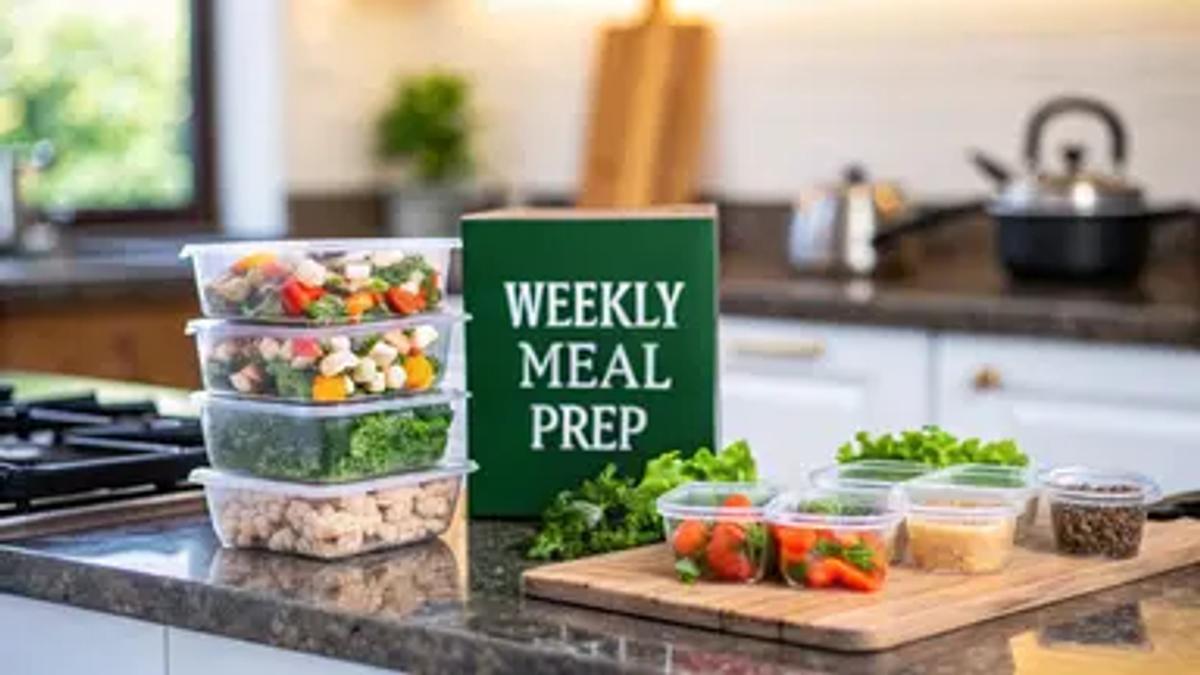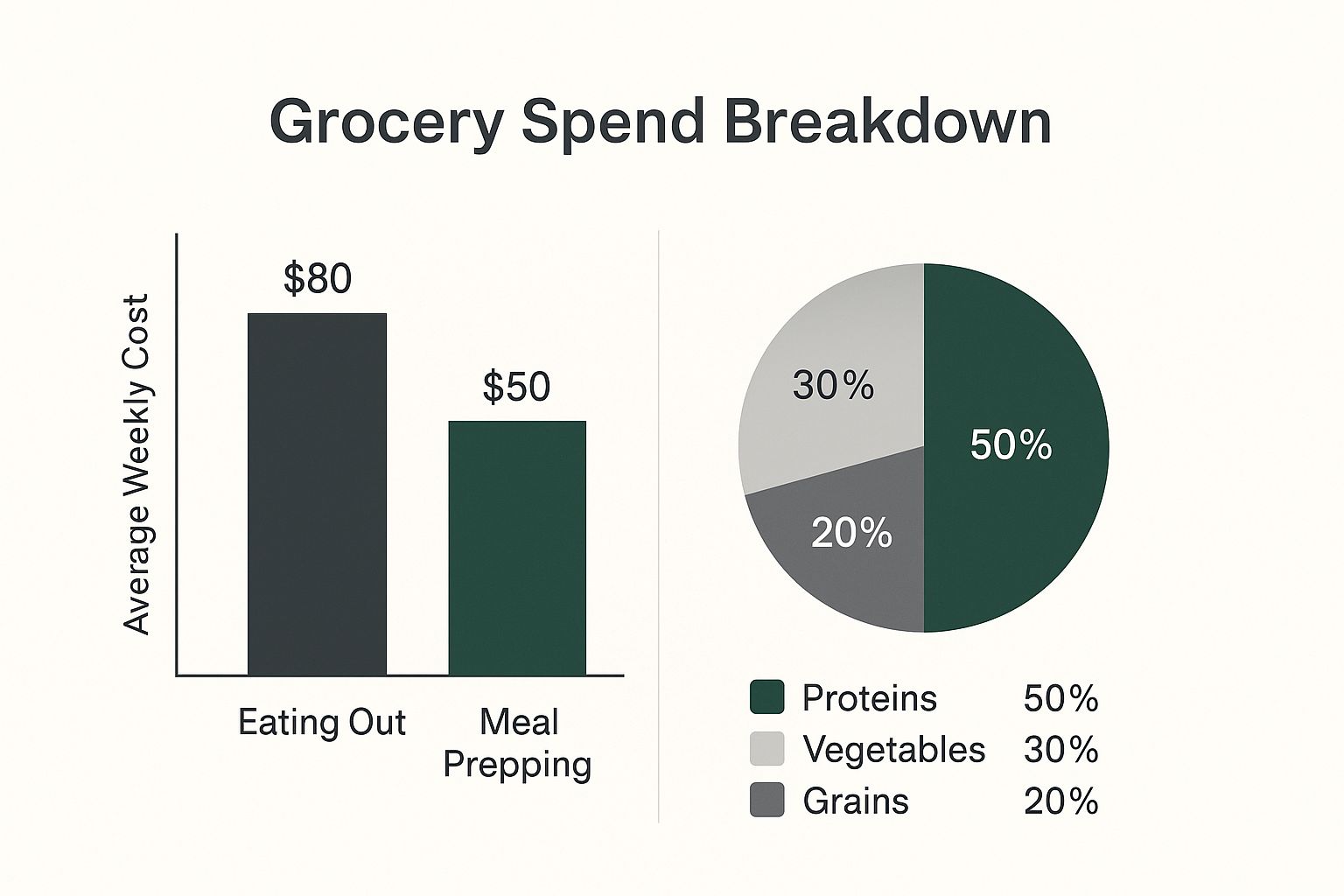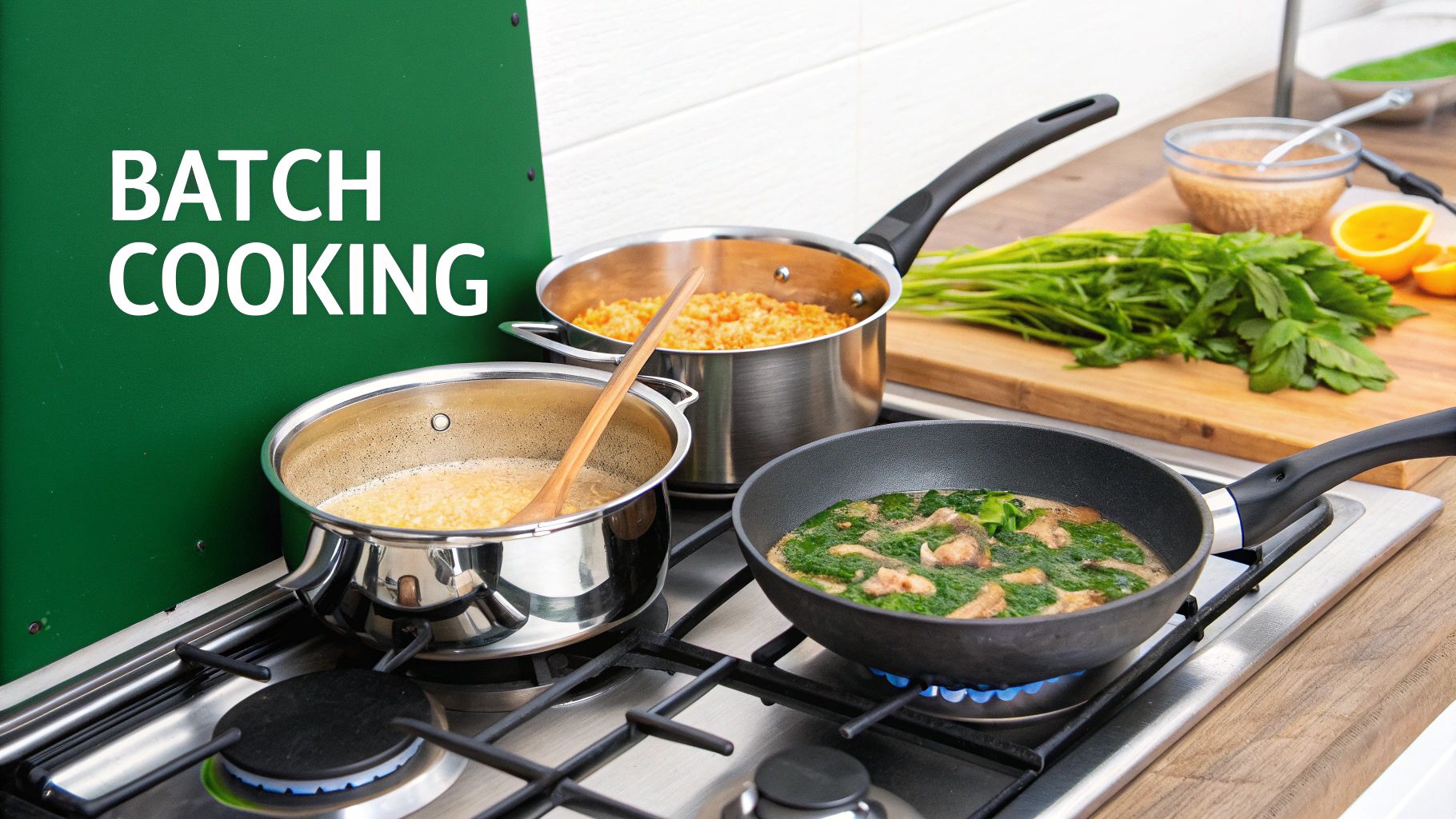How to Meal Prep for the Week Like a Pro: Complete Guide
Master how to meal prep for the week with expert strategies that actually work. Save time, eat healthier, and eliminate kitchen stress.
Love This Article?
Get personalized meal plans with recipes like this, automatically matched to your nutrition targets.

How to Meal Prep for the Week Like a Pro: Complete Guide
Getting Started Without Overwhelming Yourself
Jumping into meal prep can feel like a huge commitment. We've all seen those flawless, color-coded fridges on Instagram and thought, "Yeah, right. Not in my house." But here’s a little secret from those of us who've been doing this for a while: success isn't about creating that social media fantasy on your first try. The real victory is turning meal prep from a Sunday chore you dread into your secret weapon for a stress-free week.
Before you even think about buying new containers or chopping an onion, take a second for a reality check. Where are you really struggling? Is it the mad dash to find breakfast in the morning? The daily $15 lunch habit that’s draining your bank account? Or is it the constant takeout orders because you're just too exhausted to cook by dinnertime? Pinpointing these specific issues gives your meal prep a clear mission. It stops being about "cooking a bunch of food" and starts being about solving your actual problems.
Set Realistic Goals, Not Perfect Ones
Honestly, the biggest reason people give up on meal prepping isn't a lack of time—it's burnout from setting the bar way too high. Trying to prep breakfast, lunch, and dinner for seven days straight right out of the gate is a surefire way to crash and burn. Instead, let's start small and build from there.
Here’s a practical game plan to get you started on the right foot:
- Target One Meal: Pick the meal that causes you the most chaos. For a lot of people, that’s lunch during the work week. Just focus on prepping your lunches and nothing else.
- Prep Ingredients, Not Full Meals: This is a game-changer. Instead of assembling five identical chicken salads, just cook a batch of chicken, wash and chop your lettuce, and mix up a jar of dressing. This gives you amazing flexibility. Monday it’s a salad, Tuesday it’s a chicken wrap, Wednesday it’s chicken and rice.
- Start with Two or Three Days: You don’t have to conquer the whole week. Commit to prepping for Monday, Tuesday, and Wednesday. It feels so much more doable and helps you build the habit without the immense pressure of a full seven-day spread.
Evaluate Your Kitchen Space
Finally, do a quick inventory of what you’re working with. You don’t need a bunch of high-tech gadgets, but you do need the basics to be functional. Do you have enough containers for three lunches? Is there actually room in your fridge for them? Understanding your kitchen's limitations from the start will keep you from cooking way more food than you can store.
This isn't just about making your life easier; it's part of a massive global trend. People everywhere want healthier, more convenient meals. That’s why the meal prep market was valued at USD 5.68 billion in 2024 and is on track to more than double. You can check out the full breakdown in this global meal kit industry report. Starting with an honest look at your habits and your kitchen is the first real step in figuring out how to meal prep for the week in a way that actually works for you.
Building Weekly Menus That Actually Work

This is where the magic really happens. A great meal plan isn't about stuffing your week with seven new gourmet recipes. It's about designing a menu you’ll actually want to eat, especially on that dreaded Wednesday when your energy is gone and ordering a pizza sounds like the best idea you’ve ever had. The goal here is to beat meal fatigue—that feeling of boredom that tempts you to abandon your perfectly prepped food for something, anything, else.
It's no secret that people are looking for easier ways to eat well. With our busy lives, traditional cooking has become a real challenge for many. The U.S. meal kit market was valued at over USD 5.9 billion in 2024, a number fueled by professionals and families who just need more convenient options. You can read more about these changing lifestyle trends on gminsights.com. This just shows how valuable a smart, repeatable menu plan has become.
The Power of Ingredient Overlap
If there's one trick that seasoned meal preppers live by, it's ingredient overlap. This doesn't mean you're doomed to eat the same sad lunch for five days straight. It's about picking a few core ingredients you can use in totally different ways across your meals. This is a game-changer for cutting down on food waste and making your grocery list a lot less intimidating.
Here’s a real-world example of how it works:
- Sunday Roast Chicken: You kick off the week with a classic roast chicken dinner with all the fixings.
- Monday Chicken Wraps: That leftover shredded chicken gets a new life as the hero of some quick and delicious lunch wraps with lettuce, cheese, and a tortilla.
- Wednesday Chicken Noodle Soup: You use the chicken carcass to make a rich, flavorful broth for a comforting soup to get you through the midweek slump.
With this method, nothing gets tossed out, and every meal feels fresh. You’re not just reheating leftovers; you’re giving them a whole new purpose.
Balancing Variety and Simplicity
One of the biggest mistakes I see people make is getting too ambitious. They plan a menu with so much variety that their prep day turns into an exhausting, all-day cooking marathon. You need to find the sweet spot between keeping things interesting and keeping things simple. A framework I love is the 2+2+1 method:
| Meal Type | Description |
| Two Core Meals | These are your tried-and-true workhorses, like a big batch of chili or a simple pasta bake. |
| Two Flex Meals | These are assembled from prepped components. Think grain bowls or a "big salad" with various toppings. |
| One "Fun" Meal | This is your wildcard—a new recipe you've been wanting to try, or even a planned night for takeout. |
This structure gives you consistency you can count on but leaves room for a little fun. If you want to take the guesswork out of it, a tool like Meal Flow AI can build a balanced weekly plan for you. It considers your tastes and automatically creates a plan with smart ingredient overlap, freeing you from the mental work so you can actually enjoy the cooking.
Shopping Strategies That Save Time and Money
With your meal plan locked in, it’s time for the next mission: turning your grocery run from a mad dash into a tactical strike. This is where you really learn how to meal prep for the week like a pro, transforming a chore you dread into a win for both your schedule and your bank account. I’ve learned over the years that how you shop is just as important as how you cook.
First, let's talk about the grocery list. That random scrap of paper or a jumbled note on your phone just won't cut it. Your list needs to mirror the store's layout. Think about your typical path: produce first, then pantry items, followed by proteins, and finally the frozen aisle. This “aisle-by-aisle” approach stops you from zig-zagging across the store and keeps you focused, which can seriously slash your shopping time. For example, I group all my veggies (onions, bell peppers, spinach) together, then move on to dry goods like quinoa and canned beans, following a logical path right to the checkout.
Smart Shopping Frequency and Sales
You might think one huge weekly shop is the most efficient way to go, but the reality is a bit more nuanced. Some of your fresh ingredients just won't make it a full seven days. I've found a hybrid approach works wonders:
- The Big Weekly Shop: This is for all your long-lasting items—pantry staples, grains, proteins, and tougher vegetables like carrots and potatoes.
- A Quick Mid-Week Top-Up: I’ll often do a quick run for delicate produce like fresh berries, leafy greens, or avocados. This ensures they're perfectly fresh when I’m ready to use them later in the week.
This infographic really puts into perspective how much you can save and where your grocery money typically goes when you meal prep.

As you can see, cooking at home is a massive money-saver compared to eating out, with most of the budget going toward the good stuff: essential proteins and veggies.
Being smart about sales is another skill you'll develop. Don't let a "buy one, get one" deal throw off your whole plan unless you have an immediate use for the extra item or can freeze it. For instance, if ground beef is on sale, it's a perfect chance to double a recipe for spaghetti sauce or chili—one batch for this week, and one for the freezer. This is where a tool like Meal Flow AI becomes a game-changer. After it builds your meal plan, it automatically generates an Instacart shopping list. This not only saves a ton of time but also keeps you disciplined, helping you avoid those pricey impulse buys that always seem to sneak into the cart. When you order groceries online from a precise list, the temptation of store displays simply vanishes.
Mastering Prep Day Without Burning Out

This is where your plan meets the reality of your kitchen. A successful prep day isn't about frantically cooking for five hours straight; it’s about working smarter, not harder. The secret is setting up a workflow that respects your time and energy, so you end the day feeling accomplished, not completely wiped out. Think of yourself as an air traffic controller for your kitchen—you need a clear plan to get everything done without causing a culinary pile-up.
The first thing seasoned meal preppers do is establish an order of operations. You want to start with the foods that take the longest to cook but require the least hands-on attention. For instance, get your quinoa or brown rice simmering on the stovetop or a whole chicken roasting in the oven first. While those are cooking away, you can tackle your more active prep tasks. This simple strategy keeps you productive instead of just standing around waiting for water to boil.
Efficient Cooking and Food Safety
Once you get into a groove, you can start running multiple appliances at once. It's a common practice for experienced home cooks to have a tray of vegetables roasting in the oven while chicken sears on the stove and a soup simmers in the slow cooker. This approach is a total game-changer for anyone figuring out how to meal prep for the week without losing their entire Sunday.
Here’s a typical prep day workflow that really works:
- Roast & Simmer: Kick things off with oven-roasted items (like sweet potatoes or chicken) and any slow-cooking grains.
- Chop & Prep: While those items are cooking, wash and chop all your vegetables for the week. This is often the most time-consuming part, so getting it done while other things cook is a huge win.
- Stovetop Cooking: Next, move to the stovetop to sauté ground beef, pan-sear fish, or whip up a quick sauce.
- Cool & Store: As dishes finish, let them cool completely on the counter before putting them in containers. This is vital for food safety and prevents condensation, which is the enemy of crispy, fresh-tasting leftovers. Trapping steam in a sealed container creates a warm, moist environment where bacteria can have a field day.
Ingredient Prep vs. Full Meals
Deciding whether to prep full meals or just individual ingredients really comes down to personal preference and how much flexibility you want during the week.
| Prep Style | Best For | Pros | Cons |
| Full Meals | Anyone who wants zero-thought, grab-and-go lunches and dinners. | Ultimate convenience | Less variety, can lead to meal fatigue |
| Ingredients | People who crave variety and want to assemble different meals on the fly. | Maximum flexibility | Requires a few minutes of assembly |
For example, you could prep fully assembled burrito bowls for the week. On the other hand, you could simply cook a batch of seasoned ground beef, chop up lettuce and tomatoes, and make a big container of cilantro-lime rice. With the ingredients prepped, you could have a burrito bowl one day and tacos the next, keeping your meals interesting. This kind of strategic cooking is the key to conquering your prep day without getting overwhelmed.
Storage Solutions That Keep Meals Fresh
You just put in the hard work to prep a fantastic week of meals, so let's make sure none of it goes to waste. The containers you use and how you pack them are just as important as the cooking itself. Your mission is to keep everything fresh, avoid sogginess, and ensure Thursday's lunch is as delicious as it was on Sunday.
The glass versus plastic debate can feel endless, but my practical take is this: invest in quality, airtight glass containers for most of your meals. They don’t stain, won't hold onto that lingering curry smell, and can go straight from the fridge to the microwave or oven. I find plastic containers are fine for lighter things like salads or snacks, but for longevity and easy reheating, glass is the undisputed champion.
Smart Portioning and Organization
Portioning your food isn't just about managing serving sizes; it’s a strategy for preserving texture. When packing lunches, always keep wet and dry ingredients separate until you’re ready to eat. For instance, put your salad dressing in a tiny, separate container and only add it right before you dig in. For grain bowls, I like to layer them: grains on the bottom, then proteins and firm veggies, and finally, leafy greens on top. This keeps them from getting crushed and wilted.
Labeling will become your best friend in this process. A little piece of masking tape and a sharpie with the meal's name and date is all it takes. This simple habit stops the fridge-guessing-game and helps you use a first-in, first-out system so nothing gets forgotten in the back. For freezer meals, this is absolutely non-negotiable—it's the only way to avoid discovering a mystery meat block six months from now.
To help you know exactly how long your prepped items will last, here's a quick reference guide comparing different storage methods.
#### Food Storage Timeline and Methods Comparison
Detailed breakdown of how long different prepped foods last using various storage methods and optimal reheating instructions
| Food Type | Refrigerator (Days) | Freezer (Months) | Best Container Type | Reheating Method |
| Cooked Grains (Rice, Quinoa) | 3-4 | 2-3 | Airtight Glass/Plastic | Microwave with a damp paper towel or on the stovetop. |
| Grilled Chicken/Meats | 3-4 | 2-3 | Airtight Glass | Oven at 350°F (175°C) or microwave. |
| Roasted Vegetables | 3-5 | 6-8 | Airtight Glass/Vacuum Seal Bag | Oven or air fryer to restore crispiness; avoid microwave. |
| Soups and Stews | 3-4 | 2-3 | Airtight Glass/Plastic, Mason Jars | Stovetop over medium heat or microwave in bursts. |
| Leafy Green Salads (Undressed) | 2-3 | N/A | Plastic Container with Paper Towel | N/A |
| Chopped Raw Vegetables | 4-5 | N/A | Airtight Container with Paper Towel | N/A |
As the table shows, the freezer is your best bet for long-term storage, especially for proteins and stews, while the fridge is perfect for grab-and-go meals you plan to eat within the work week.
Advanced Storage Techniques
If you're really serious about making your meals last, a vacuum sealer is a game-changer. By removing all the air, it drastically slows down spoilage and prevents that dreaded freezer burn. It’s incredibly effective for proteins like chicken or fish and for hearty soups and stews.
Here’s a great trick I’ve picked up for things like chopped vegetables: place a folded paper towel at the bottom of the container. This super simple move absorbs any extra moisture, which is the main culprit behind wilting and sliminess. By using these storage methods, you're not just putting food away; you're preserving the time and effort you invested in learning how to meal prep for the week.
Making Meal Prep Stick Long-Term
Let's be real. The hardest part of learning how to meal prep for the week isn't getting the hang of chopping veggies or figuring out how to Tetris everything into your fridge. The real test is making it a habit that can handle life’s unexpected twists and turns. That first wave of motivation is great, but long-term success comes from a system that can bend when life gets chaotic.
Perfect, smooth-sailing weeks are pretty much a myth. The goal isn’t to be a perfect meal prepper who never misses a beat; it's to make it incredibly easy to get back on track when you do. One of the biggest obstacles is that classic Sunday slump—you know, when the couch is practically screaming your name and the thought of cooking feels impossible. This is where perfectionism can sabotage you. If you miss your planned prep time, don't throw in the towel for the whole week.
Instead, just adjust your plan. Could you do a quick mini-prep on Monday morning? Maybe just cook up a big batch of chicken and rice to get you through a few days? Giving yourself the grace to do an "imperfect" prep is always better than doing nothing at all.
Troubleshooting Common Meal Prep Problems
Even with the best intentions, things like food boredom and a creeping grocery bill can throw a wrench in your plans. It helps to see these coming.
- Fighting Meal Fatigue: While online chatter about meal prep has cooled a bit, with social media discussions dropping by 12.80% lately, its core appeal is as strong as ever. The secret to sticking with it is focusing on versatile staples. Think chicken, rice, and pasta—ingredients you can easily spin into different meals. You can find more insights on these popular meal prep ingredients and trends on tastewise.io. So instead of making five identical salads, prep the components: grill some chicken, roast a pan of veggies, and mix up a vinaigrette. Now you have the building blocks for a salad one day, a wrap the next, and maybe a grain bowl after that.
- Managing Your Budget: Did your grocery total give you a bit of a shock? It might be time to look at your menu. Are you choosing pricey, out-of-season produce or buying specialty items for just one recipe? Bring it back to basics with affordable powerhouses like beans, lentils, and whatever vegetables are in season and on sale.
Making It a Lifestyle, Not a Chore
To truly make meal prep a permanent part of your routine, you have to find the joy in it. Frame it as an act of self-care rather than another task on your to-do list. Pop on an engaging podcast or blast your favorite album while you cook. Get the family involved—even little kids can have fun washing vegetables or helping you layer ingredients for a parfait.
Honestly, one of the best rewards is waking up on a hectic Tuesday morning and knowing a delicious, healthy lunch is already packed and waiting for you. That little moment of calm is what it's all about. It’s that feeling of relief that will keep you coming back to your kitchen, week after week, until it becomes second nature.
Your Meal Prep Success Blueprint
Let's be real: mastering how to meal prep for the week isn't a final destination. It’s a skill that grows and changes with you. Forget the pressure from social media to have a perfectly color-coded, Instagram-worthy fridge. True success is all about how well your prep routine actually fits your real, sometimes messy, life. The best plan is one that can bend without completely breaking.
From Beginner to Pro: Gradual Improvements
Your journey starts with small, totally doable goals. If you're just starting out, concentrate on a simple, beginner-friendly plan. This could be as easy as prepping just three lunches for the work week or batch-cooking one versatile protein, like shredded chicken, that you can use in different meals.
Once you feel more comfortable, you can start adding more advanced tricks. For instance, you could move from prepping full meals to prepping components—think chopped veggies, pre-mixed sauces, and cooked grains. This gives you way more flexibility when dinner time rolls around. The goal is to build habits that stick, not to achieve perfection overnight. A realistic first step could be cutting your weekly takeout orders by just one or two meals. Honestly, that’s a huge win!
Troubleshooting Common Setbacks
Even seasoned meal preppers run into trouble. We've all been there—you're bored with your food, or your grocery bill suddenly feels way too high. Here’s how to handle it:
- For Dietary Needs: Switching things up for a new dietary need, like going gluten-free, can feel like a massive task. Don't try to change everything at once. Start by finding a few solid recipes that fit the bill, like a delicious White Bean & Chickpea Salad, and expand your menu from there.
- For Budget Constraints: When money is tight, lean into affordable staples. Build your meals around seasonal veggies, beans, and lentils. A simple spaghetti with meat sauce can be incredibly satisfying and easy on the wallet.
- For Time Limitations: On those super busy weeks, oven-free, assembly-only meals are your best friend. A high-protein buffalo chicken dip or some fruit and yogurt parfaits can be prepped in minutes, keeping you on track without adding more stress to your plate.
Ultimately, your success blueprint is personal. It’s about building a system that gives you back your time, saves money, and cuts down on that "what's for dinner?" stress. Ready to create a plan that truly works for you, without all the mental heavy lifting? Let Meal Flow AI design your personalized weekly menu and Instacart shopping list, so you can focus on the best part—enjoying your delicious, stress-free meals.